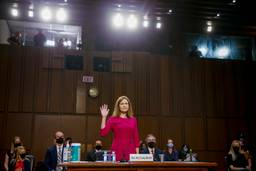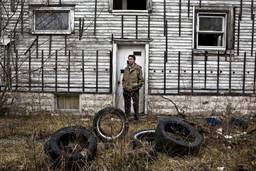On August 5, 2021 labor advocates across the country lost a champion with the death of AFL-CIO president Richard Trumka. Eleven days later, another working-class advocate, activist-sociologist Stanley Aronowitz, succumbed to a long illness. Between the arc of their overlapping but very different careers lay both the promise and tragic unfulfillment of the ideal of worker-centered democracy, an ideal to which each was deeply committed.
Trumka’s achievement seemed to mark the range of the possible at the helm of a divided and deeply-wounded labor movement. Born to Polish-Italian parents in Pennsylvania mining country in 1949, Trumka followed his father into the mines before attending college and law school and taking a job as staff attorney for the United Mine Workers of America (UMWA) at their headquarters in Washington, D.C. Elected to an executive board position in 1981 and then union president in 1982, Trumka adapted contemporary currents of rights consciousness and community organizing to traditions of rank and file militancy within a UMWA structure reeling from industrial decline, technological displacement and union corruption. The extended Pittston strike in 1989 in which the union beat back the use of replacement workers not only restored the union’s fighting spirit but by linking labor activism to nonviolent civil disobedience of African American and anti-apartheid civil rights struggles, Trumka suggested that Big Labor might yet return to its social movement roots.
Radical hopes were widely invested in Trumka’s election as AFL-CIO secretary-treasurer on John Sweeney’s insurgent “New Voice” slate in 1995. In that moment, years of sliding membership and feckless obeisance to a Democratic Party that would neither enact labor law reform nor blunt job loss from NAFTA, finally tipped the scales against the incumbent regime of Lane Kirkland and his preferred replacement, federation secretary-treasurer Tom Donahue.
In the first open presidential campaign in AFL-CIO history, the New Voice slate swept to victory on the basis less of national union presidential backing than grassroots mobilization within state and local labor federations. On a tide of enthusiasm, New Voice leaders — hoping to replicate Sweeney’s success in pressuring management for contracts at the Service Employees (SEIU), the nation’s largest and fastest growing union — pushed other federation affiliates to enhance organizing budgets, recruit women and minorities to leadership positions, and open their ranks to a sprawling new immigrant workforce.
Pushing back against an increasingly conservative, Republican-led Congress, the AFL-CIO poured resources into local and state as well as federal election campaigns; its highest PAC contributions ever were recorded from 1996 to 2008 .
Despite reduced resources, it could still claim credit for tipping key states like Pennsylvania and Ohio to Obama in 2008.
As AFL-CIO president upon Sweeney’s retirement in 2009, Trumka aimed to extend the New Voice agenda with a vigorous outreach to the unorganized. His spirit is perhaps best represented in the Jobs with Justice movement, a coalition of local unions and community groups that he co-founded in the late 1980s in an attempt to organize low-wage workers both inside and outside the traditional corridors of collective bargaining. As he told AFL-CIO convention delegates in Los Angeles in 2013, the organization needed to “do some things differently.”
In practice, however, Trumka found it hard to advance the labor reformers’ agenda. While contending with fallout from the nation’s financial crisis and the continued hemorrhaging of manufacturing jobs, the federation faced an economic crisis of its own, owing to the defection — a few years before Trumka’s accession — of powerful affiliates like SEIU and the Teamsters from the AFL-CIO. Forced to balance the wants of progressive affiliates like the food service workers in UNITE HERE and the American Federation of Teachers with more conservative bastions in the building trades, Trumka’s own progressive instincts were sometimes muddled by considerations of realpolitik. Most pointedly, following the murders of both Michael Brown and George Floyd, Trumka struggled to balance condemnations of racism with defense of the affiliation agreements of some 100,000 police officers with the AFL-CIO. Meanwhile, for the federation as a whole, slumping membership figures required tightened budgets and a curtailment of new organizing initiatives. A split in his own ranks, a function of both racial and geographic divisions, largely pushed the AFL-CIO off the front lines of the burgeoning anti-Trump resistance post-2016.
Trumka, a Biden supporter in 2020, pushed hard for the vital labor law reform Protecting the Right to Organize, or PRO Act. As of this writing, however, the best that can be hoped for is that certain, as yet unspecified, aspects of the PRO Act may be folded into the Democrats’ omnibus reconciliation bill.
Is there a playbook whereby the AFL-CIO, as currently configured, can re-orient American capitalism to enhance worker power? Even among labor’s longtime friends, many are skeptical. The baton, in any case, passes to close Trumka ally, former secretary-treasurer and now newly-designated president Liz Shuler.
If Trumka represented the best impulses of the actually existing labor movement, Stanley Aronowitz dreamed of a more ambitious movement. A Bronx-born metal-worker, union organizer (for the Oil, Chemical, and Atomic Workers Union in New Jersey), and civil rights activist, Stanley at age 35 completed a B.A. at the New School for Social Research in 1968, earned a PhD in sociology at the Union Graduate School in 1975, and then taught, wrote, and agitated from his perch at the Graduate Center of the City of University of New York. Ever exuberant in person and prose, he embodied the effective reach and limitations of the New Left sensibility that echoed even as it evolved across 25 books (as author or editor) on work and labor, social class, education, and technology. His influence was manifest in many leftwing initiatives, including Studies on the Left, the Socialist Scholars Conference and Social Text, which he served as founding editor in 1979, and even a run for governor of New York on the Green Party ticket in 2002 .
Across Aronowitz’s multifaceted work, likely no theme tracked more constantly than his critical, and often acerbic, commentary on the workers’ movement in which he had cut his teeth. The brunt of Aronowitz’s criticism — and a stance from which he never backed away — was contained in his first, and most influential work, False Promises: The Shaping of American Working-Class Consciousness (1973). Drawing on Aronowitz’s own workplace experience, his readings in Marxism and cultural theory and interest in popular culture, a generational rebellion against capitalist regimentation burst from its pages. The book drew praise from Noam Chomsky and Herbert Marcuse. Organized labor — the bearer of a ‘false promise’ of freedom and opportunity for the working class — took it on the chin. “The unions,” he declared, “have all but abandoned the fight for decent working conditions, and, insofar as they are perceived as staunch defenders of the status quo…are increasingly looked upon as enemies.” Aronowitz condemned even the Wagner Act, that symbol of the unions’ role in the New Deal Order, for mollifying a class struggle against alienated work itself that might otherwise take off from within an increasingly young and multi-racial new working class.
Yet Aronowitz would soon temper his assessment of what was possible. In Working Class Hero: A New Strategy for Labor (1983), a self-described sequel to False Promises, he allowed that his exuberance had led him to exaggerate the transformative potential of the ’60s social movements and to shortchange both union’s past accomplishments and the continuing need for progressives to look to organized labor for leadership. Connected to this reconsideration, however, was his continuing focus on “post-materialist” issues associated with feminism, Black liberation, and worker self-management. Only by breaking free from the grip of business unionism and a narrow contractualism could a new working class of women, minorities, and the “technical intelligentsia” stem the portent of economic decline. By 1998, when Aronowitz published From the Ashes of the Old: American Labor and America’s Future, the ranks of organized workers in the private sector had plunged from 35 % in the 1940s to less than 10 percent. Yet, if his tone was more intense, his message remained largely the same: only a “militant minority within unions and the larger workers’ movement” could push organized labor to be “more combative in challenging capital and the repressive state” over “the super-exploitation of the working poor.”
For him that meant less dependence on the Democratic Party and a fighting focus on the South, the working poor, professional and technical employees, and low-paid white-collar workers.”
Sixteen years later, in his last major word on the subject—The Death and Life of American Labor: Toward a New Workers’ Movement (2014) — Aronowitz combined a by-now-familiar critique of mainstream unions (i.e. lack of militancy, diversity and internal democracy) with applause for the green shoots of direct action he identified with minority unionism, the Fight for 15, and short duration protest strikes. Albeit unmentioned by Aronowitz, these positive sprigs had also all been championed by AFL-CIO President Trumka, ever seeking new strategies.
What did it mean, then, that when one of labor’s most voluble internal critics and its chief executive officer finally found common political ground, it turned out to be on a largely arid plain? Together, the unions and their community allies have most successfully formed a social movement when both were in dialogue with intellectuals who connected their struggles across wider arcs of meaning. Like “good trouble,” we need that useful “internal friction” again. We have lost two dedicated and honorable souls who did their best for the dignity of American workers. Alas, the cause has miles to go.








